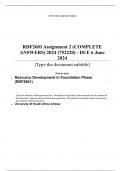[TYPE THE COMPANY NAME]
RDF2601 Assignment 2 (COMPLETE
ANSWERS) 2024 (752220) - DUE 6 June
2024
[Type the document subtitle]
[Pick the date]
Resource Development in Foundation Phase
(RDF2601)
[Type the abstract of the document here. The abstract is typically a short summary of the contents of
the document. Type the abstract of the document here. The abstract is typically a short summary of
the contents of the document.]
University Of South Africa (Unisa)
, 100% TRUSTED workings, explanations and
solutions. ............
Exam (elaborations)
RDF2601 Assignment 2 (COMPLETE ANSWERS) 2024
(752220) - DUE 6 June 2024
Course
Resource Development in Foundation Phase (RDF2601)
Institution
University Of South Africa (Unisa)
Book
An Introduction to the Foundation Phase
RDF2601 Assignment 2 (COMPLETE ANSWERS) 2024 (752220) - DUE 6
June 2024 ;100% TRUSTED workings, explanations and solutions. ............
QUESTION 1: (38) Learning and teaching support materials / resources
(LTSM) provide the structure for teaching within which learners explore,
experiment, plan and make decisions for themselves, thus enabling them to
learn, develop and make good progress. 1.1. Briefly provide the importance of
resources and complete the following table to emphasise the structure LTSM
provide for teaching and learning. (10) A brief explanation of the resources (1)
Name three categories of resources you can use to enhance your teaching
and learning in the Foundation Phase (3). Provide an example of each
category (3). Explain how each identified resource can be used in the
teaching of the following Foundation Phase subjects: - Mathematics - Home
Language - First Additional Language - Life Skills (3)
, Significance of Learning and Showing Backing Materials (LTSM)
Learning and Showing Backing Materials (LTSM) are fundamental in
training as they give an organized climate where students can
investigate, examination, plan, and decide. These materials are urgent
for: Improving Comprehension: Assets like books, visual guides, and
advanced apparatuses assist with making theoretical ideas more
concrete and justifiable. Drawing in Understudies: Intelligent and
fluctuated materials keep up with understudy interest and commitment,
making learning more agreeable. Supporting Assorted Learning Styles:
Various assets take care of different learning styles (visual, hear-able,
sensation), guaranteeing all understudies have the potential chance to
actually learn. Working with Dynamic Learning: Assets empower
involved exercises and viable applications, advancing further learning
and maintenance of information. Empowering Free Learning: Assets
engage understudies to investigate and advance autonomously,
cultivating decisive reasoning and critical thinking abilities.
Classifications of Assets and Models Table Finishing Brief Clarification
of the Resources Categories of Resources Example of Each
Category Use in Establishment Stage Subjects Assets are materials
that guide in educating and getting the hang of, giving design and
improving comprehension. Actual Resources Manipulatives (e.g.,
counting blocks) Mathematics: Counting blocks for figuring out
expansion and deduction. Home Language: Storybooks for
understanding practice. Computerized Resources Educational
Programming (e.g., proficiency apps) First Extra Language: Language
applications for jargon building. Visual Resources Posters (e.g., letters
in order charts) Life Abilities: Banners for finding out about solid
propensities. Point by point Clarification of Asset Use Actual Assets
(Manipulatives) Model: Counting blocks Math: Counting blocks can be
utilized to show fundamental number-crunching activities, for example,
expansion and deduction by permitting understudies to truly control the
blocks to figure out the ideas. Home Language: Storybooks can be
utilized to foster understanding abilities, cognizance, and jargon by
connecting with understudies in shared understanding meetings. First
Extra Language: Cheat sheets can assist in jargon securing and
language with rehearsing through visual and monotonous learning.
Fundamental abilities: Manipulative models can be utilized in exercises
that show coordinated movements, spatial mindfulness, and critical
thinking. Computerized Assets (Instructive Programming) Model:
Proficiency applications Arithmetic: Instructive programming can give
intelligent numerical games and exercises that support numerical ideas




